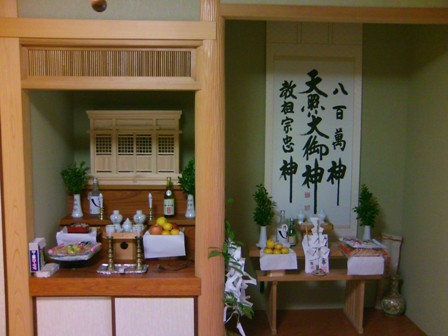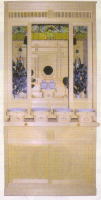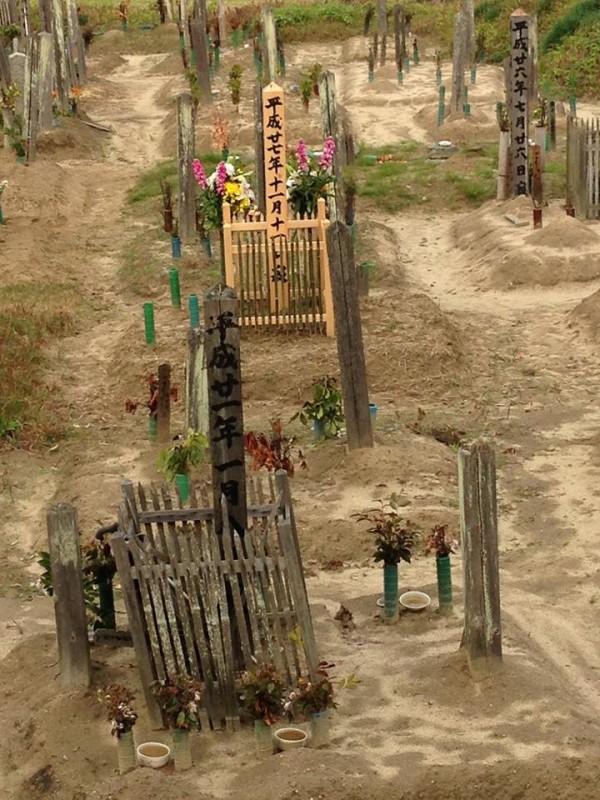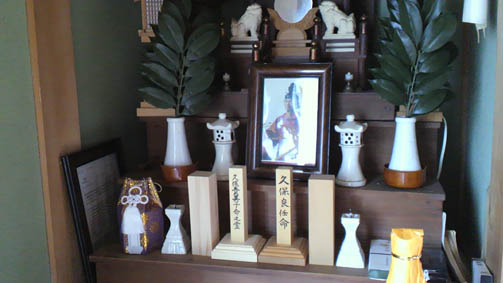
A mitamaya spirit shelf (see bottom of page for further explanation)
This is Part Ten of an ongoing series about the Shinto way of death, adapted with permission from an academic article by Elizabeth Kenney. It shows how traditional Shinto arrangements differ from those of the Buddhist funeral. Though the research was carried out in the 1990s and some of the information is dated, the fundamentals still apply. For the original article, see Elizabeth Kenney ‘Shinto mortuary rites in contemporary Japan.’
Memorial rites
Shinto memorial observances are modeled on Buddhist memorial services. Buddhist memorial services are held every seven days after the death until the forty-ninth day (7 x 7). According to Buddhist doctrine, a person spends forty-nine days in the intermediate existence before his next rebirth, so this transitional period is crucial.
According to popular understanding, it takes forty-nine days for the spirit to go the Pure Land (or to be reborn). During that interval, the spirit can benefit from the prayers and offerings of the living.
Some places in Japan count the day of the death itself as day number one, and other places do not. That is to say, if a death occurs on a Sunday, the seventh-day memorial service is held either on the next Saturday (six days later) or the next Sunday (seven days later), depending on the area.

Shinto rejects multiples of seven, since the Buddhist connotations are too strong. Instead, Shinto, using multiples of ten, and holds its rituals on the tenth, twentieth, thirtieth, fortieth and fiftieth days after death. (Notice that fifty ends up very close to the Buddhist forty-nine.)
The “epitaph” is described as a copper sheet or stone slab one shaku long (about 30 cm). Inscribed on the epitaph are the name and rank of the deceased and the dates of his birth and death. The single “epitaph” mentioned by Gorai (1992) is something different, for it reads like one of the Chinese land-purchasing contract for graves discussed in Anna Seidel’s “Post-mortem Immortality.” It seems that the Shinto dead need some identification and a brief curriculum vitae to take with them as they cross the border into a strange country.
The mourner’s staff is a widespread folk custom, and there is nothing specifically Shinto about it. In a Buddhist context, the staff is a pilgrim’s staff or a monk’s staff, which the deceased will use on his journey. In the folk tradition, the staff may represent fertility (phallic?) or generational continuity (which, after all, depends on fertility), or it may offer a kind of companionship to the deceased in his grave. Sometimes the staff is stuck straight up on top of the grave mound, making it a kind of lightning rod to attract the spirit or gods. The staff then also mimics the chopsticks stuck into the rice.

A Shinto graveyard in Kyoto Prefecture (courtesy Keith Adams)
In the Buddhist case, the next memorial service after the forty-ninth day is held on the hundredth day. Then, on the first anniversary of the death, another memorial service is held. Afterwards, anniversary rites are held in the following years: third, seventh, thirteenth, seventeenth, twenty-second, twenty-seventh, thirty-third, fiftieth, and hundredth. Each of these anniversaries is calculated by counting the year of the death as 1 , so that the “third” anniversary is two years after the death, and so on.
In Shinto, the tenth-day and following memorial services are often conducted in front of the grave. After one year, the memorial services are held in the house. Later, Shinto memorial services are held on the following anniversaries of the death: first, second (optional), third, fifth, tenth, twentieth, thirtieth, fiftieth, and hundredth.
After fifty days, the reiji is moved from its solitary position on the temporary altar to the household ancestral altar, where it joins the other ancestors. The spirit has passed through its liminal period, shed its pollution, and is ready to assume responsibilities as the family’s guardian deity. The house is purified and the paper is removed from the kamidana (spirit shelf) and ancestral altar. The family is now free from impurity and may worship at a shrine as usual. In practice, many families prefer to wait longer than fifty days before entering a shrine, often for one year.

Mitamaya, a place for enshrining the spirits of ancestors

Leave a Reply